
|
Gaius Iulius Hyginus (Caspar Vopel) |
C. Ivlii Higini, Avgvsti Liberti, Poeticon Astronomicon : Ad Vetervm exemplarium eorumq[ue] manuscriptorum fidem diligentissime recognitum, & ab innumeris, quibus scatebat, uitiis repurgatum, Coloniae 1534
|
Gaius Iulius Hyginus
C. Ivlii Higini, Avgvsti Liberti, Poeticon Astronomicon : Ad Vetervm exemplarium eorumq[ue] manuscriptorum fidem diligentissime recognitum, & ab innumeris, quibus scatebat, uitiis repurgatum, Coloniae 1534

https://reader.digitale-sammlungen.de/de/fs1/object/display/bsb10934130_00005.html
Caspar Vopel è l’autore delle illustrazioni delle costellazioni che corredano l’edizione del Poeticon Astronomicon pubblicata a Colonia nel 1534 da Johannes Soter. Lo stile utilizzato da Vopel ha per riferimento le costellazioni delle mappe del Dürer del 1515 e per descriverle ricorro ai seguenti articoli di Elly Dekker e di Astronomie in Nürnberg.
http://www.atlascoelestis.com/Vopel%202010%20base.htm

Vopel's next undertaking in celestial cartography was the series of forty woodcut constellation images made for the 1534 edition of the Poeticon Astronomicon, published by the Cologne humanist and printer Johannes Soter. (22)
This astronomical treatise on the rudiments of astronomy is attributed to the librarian of the Roman emperor Augustus, C. Iulius Hyginus (first century bc). Vopel's involvement in Soter's edition is expressed in an address to the reader printed at the end of the book. He also included a reference to his woodcut illustrations of Hyginus's Poeticon Astronomicon in a legend on his world map. (23)
Cycles of individual constellation images are seen in many medieval manuscripts, where they illustrate so-called descriptive star catalogues, that is, written lists of the locations of stars within constellation images. The oldest extant copies of such lists date from the beginning of the ninth century. Some descriptive star catalogues are part of the scholia of Latin translations of the Phaenomena, the earliest surviving Greek description of the celestial sky by Aratus of Soli (c. 310–240/239 bc); others occur in treatises of the ‘computus’. (24)
Book III of Hyginus's Poeticon Astronomicon contains such a descriptive star catalogue.
The most common cycle
of constellation images printed in the Renaissance is the one illustrating the editio
princeps of the Latin translation of Aratus's poem by Germanus Iulius Caesar
(15 bc–19 ad).
This was published in
The woodcuts of the
Scot illustrations were also used in the 1482 and 1485 editions of Hyginus's Poeticon
Astronomicon, published by Erhard Ratdolt in
In contrast, the
The images of Andromeda in the editions by Ratdolt and Soter of respectively 1482 and 1534 are shown in Figure 2 The 1482 image depicts Andromeda as a male/female with outstretched arms tied to the branches of trees. (27)
The stars plotted in the constellation are in keeping with Hyginus's descriptive star catalogue. Vopel's image on the other hand follows Dürer's design of a naked woman in chains. He placed the constellation in relation to sections of a number of celestial circles: great circles through the ecliptic poles separating the signs of the zodiac, the Tropic of Cancer and the equinoctial colure. In the absence of declination scales it is not possible to decide what sort of projection Vopel used, but it certainly was not stereographic. The great circles through the ecliptic poles in the woodcuts in Soter's Poeticon Astronomicon seem to represent the boundaries of globe gores and clearly anticipate Vopel's printed globe. It is, therefore, not surprising that the stars in Vopel's figure of Andromeda do not follow Hyginus's descriptive star catalogue, but are based on Ptolemy's positions and magnitudes of the stars and are numbered according to their order in his star catalogue. (28)
|
The principles underlying Vopel's woodcut of Andromeda hold for the other constellations. A few, however, diverge from the general pattern. For example, the iconography of Boötes deviates from Dürer's design in that Boötes now holds a sickle in his raised left hand, a detail that Vopel borrowed from the Scot illustration, where Boötes is portrayed as a farmer (Fig. 3).
|
Fig. 3. Boötes
from two editions of Hyginus, Poeticon Astronomicon. Woodcuts.
Left, the Radolt edition of 1482, portraying Boötes as a farmer. Right,
the Soter edition of 1534, where Boötes holds a sickle in his raised
left hand, a detail borrowed from the illustration in the Radolt
edition. (Reproduced with permission from the History of Science
Collections,
|
In some constellations unformed stars or stars belonging to a neighbouring constellation are found. For example, the image of Corona Borealis contains some stars from Serpens (Ser 1–3, 5–6), and included in the outline of Taurus are two non-Ptolemaic stars (numbered 34 and 35 and placed after the Ptolemaic Pleiades stars 30–33) and the Greek names of the Pleiades and the Hyades (Fig. 4). Hyginus discussed the Pleiades in a separate entry in Book II.21, declaring that only six of its seven stars were discernable. This could explain why Vopel increased the four Ptolemaic Pleiades stars to six. The one star name shown in Vopel's drawings, CANOPVS in Navis, is also discussed by Hyginus, although not in his entries on Navis (Books II.37 and III.36) but in the entry on Eridanus (Book II.32). All this suggests that the images were taken from something much larger, such as a set of globe gores. The rough scale (in units of 10°) for longitudes that accompanies the drawings of the zodiacal constellations is consistent with this thesis.
|
Since the Ptolemaic stellar configurations of Vopel's constellation cycle are not in line with Hyginus's descriptive star catalogue, the series must have confused readers trying to connect the text with the images. This did not, however, prevent the reproduction of either the whole cycle or part of it in a number of astronomical works printed later in the sixteenth century. (29)


https://www.astronomie-nuernberg.de/index.php?category=duerer&page=hyginus-1534
https://www.astronomie-nuernberg.de/index.php?category=duerer&page=nachfolger
https://www.astronomie-nuernberg.de/index.php?category=duerer&page=sternkarten
l
Per cortesia di

https://reader.digitale-sammlungen.de/de/fs1/object/display/bsb10934130_00005.html
Le tavole delle costellazioni

https://reader.digitale-sammlungen.de/de/fs1/object/display/bsb10934130_00005.html?zoom=0.5


https://reader.digitale-sammlungen.de/de/fs1/object/display/bsb10934130_00046.html?zoom=0.5
https://reader.digitale-sammlungen.de/de/fs1/object/display/bsb10934130_00047.html?zoom=0.5


https://reader.digitale-sammlungen.de/de/fs1/object/display/bsb10934130_00048.html?zoom=0.5
https://reader.digitale-sammlungen.de/de/fs1/object/display/bsb10934130_00049.html?zoom=0.5


https://reader.digitale-sammlungen.de/de/fs1/object/display/bsb10934130_00050.html?zoom=0.5
https://reader.digitale-sammlungen.de/de/fs1/object/display/bsb10934130_00051.html?zoom=0.5


https://reader.digitale-sammlungen.de/de/fs1/object/display/bsb10934130_00052.html?zoom=0.5
https://reader.digitale-sammlungen.de/de/fs1/object/display/bsb10934130_00053.html?zoom=0.5


https://reader.digitale-sammlungen.de/de/fs1/object/display/bsb10934130_00054.html?zoom=0.5
https://reader.digitale-sammlungen.de/de/fs1/object/display/bsb10934130_00055.html?zoom=0.5


https://reader.digitale-sammlungen.de/de/fs1/object/display/bsb10934130_00056.html?zoom=0.5
https://reader.digitale-sammlungen.de/de/fs1/object/display/bsb10934130_00057.html?zoom=0.5


https://reader.digitale-sammlungen.de/de/fs1/object/display/bsb10934130_00058.html?zoom=0.5
https://reader.digitale-sammlungen.de/de/fs1/object/display/bsb10934130_00059.html?zoom=0.5


https://reader.digitale-sammlungen.de/de/fs1/object/display/bsb10934130_00060.html?zoom=0.5
https://reader.digitale-sammlungen.de/de/fs1/object/display/bsb10934130_00061.html?zoom=0.5
Nell’elenco delle costellazioni di Igino, come anche in Eratostene, non si fa cenno ad una delle 48 costellazioni tolemaiche, il Cavallino che pertanto non viene rappresentato


https://reader.digitale-sammlungen.de/de/fs1/object/display/bsb10934130_00062.html?zoom=0.5
https://reader.digitale-sammlungen.de/de/fs1/object/display/bsb10934130_00063.html?zoom=0.5


https://reader.digitale-sammlungen.de/de/fs1/object/display/bsb10934130_00064.html?zoom=0.5
https://reader.digitale-sammlungen.de/de/fs1/object/display/bsb10934130_00065.html?zoom=0.5


https://reader.digitale-sammlungen.de/de/fs1/object/display/bsb10934130_00066.html
https://reader.digitale-sammlungen.de/de/fs1/object/display/bsb10934130_00067.html


https://reader.digitale-sammlungen.de/de/fs1/object/display/bsb10934130_00068.html
https://reader.digitale-sammlungen.de/de/fs1/object/display/bsb10934130_00069.html


https://reader.digitale-sammlungen.de/de/fs1/object/display/bsb10934130_00070.html
https://reader.digitale-sammlungen.de/de/fs1/object/display/bsb10934130_00071.html


https://reader.digitale-sammlungen.de/de/fs1/object/display/bsb10934130_00072.html
https://reader.digitale-sammlungen.de/de/fs1/object/display/bsb10934130_00073.html


https://reader.digitale-sammlungen.de/de/fs1/object/display/bsb10934130_00074.html
https://reader.digitale-sammlungen.de/de/fs1/object/display/bsb10934130_00075.html


https://reader.digitale-sammlungen.de/de/fs1/object/display/bsb10934130_00076.html
https://reader.digitale-sammlungen.de/de/fs1/object/display/bsb10934130_00077.html


https://reader.digitale-sammlungen.de/de/fs1/object/display/bsb10934130_00078.html
https://reader.digitale-sammlungen.de/de/fs1/object/display/bsb10934130_00079.html


https://reader.digitale-sammlungen.de/de/fs1/object/display/bsb10934130_00080.html
https://reader.digitale-sammlungen.de/de/fs1/object/display/bsb10934130_00081.html


https://reader.digitale-sammlungen.de/de/fs1/object/display/bsb10934130_00082.html
https://reader.digitale-sammlungen.de/de/fs1/object/display/bsb10934130_00083.html
Le tavole dei pianeti


https://reader.digitale-sammlungen.de/de/fs1/object/display/bsb10934130_00095.html
https://reader.digitale-sammlungen.de/de/fs1/object/display/bsb10934130_00096.html


https://reader.digitale-sammlungen.de/de/fs1/object/display/bsb10934130_00097.html
https://reader.digitale-sammlungen.de/de/fs1/object/display/bsb10934130_00098.html


https://reader.digitale-sammlungen.de/de/fs1/object/display/bsb10934130_00099.html
https://reader.digitale-sammlungen.de/de/fs1/object/display/bsb10934130_00100.html


https://reader.digitale-sammlungen.de/de/fs1/object/display/bsb10934130_00101.html
https://reader.digitale-sammlungen.de/de/fs1/object/display/bsb10934130_00102.html
(Nota di Atlascoelestis):
Si pensa che gli stessi stampi in legno di Vopel siano atati utilizzati nell'officina tipografica di Theodorus Graminaeus per stampare le xilografie delle costellazioni utilizzate per l'edizione del 1569 e 1570 (vedi: https://www.astronomie-nuernberg.de/index.php?category=duerer&page=graminaeus-1569) , di
Arati Solensis
PHAENOMENA ET PROGNOSTICA. Interpretibus M. Tullio Cicerone, Rufo Festo
Avieno, Germanico Caesare, Una cum Eius Commentariis. C.
Iulii Hygini Astronomicon...
Coloniae Agrippinae (
http://www.atlascoelestis.com/Aratus%20Solensis.htm
L'opera può essere consultata
nella seguente pagina
per cortesia di

in
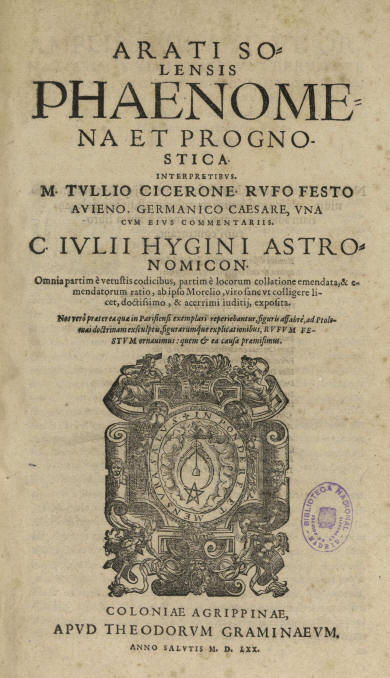
http://bdh-rd.bne.es/viewer.vm?id=0000000204
e per cortesia di

in
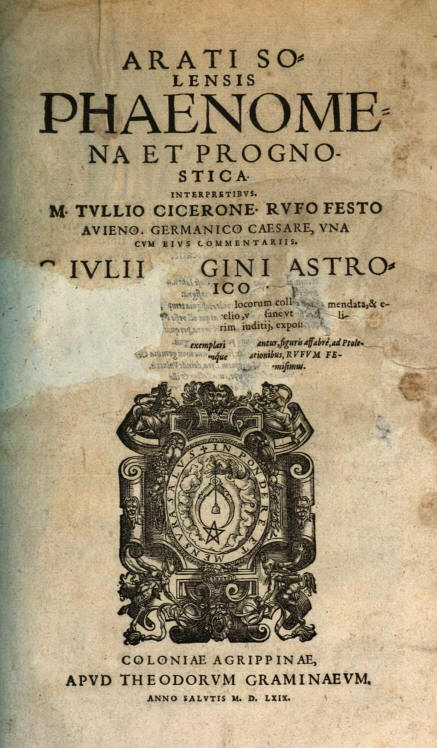
https://reader.digitale-sammlungen.de/resolve/display/bsb10139476.html
Le stesse tavole sono inserite anche in una riedizione del 1739:

https://reader.digitale-sammlungen.de/de/fs1/object/display/bsb10195820_00001.html
Di Hyginus leggi anche:
Hyginus
Poeticon Astronomicon
Arhard Ratdolt, Venezia 1485

http://www.atlascoelestis.com/Arh%20Pagina.htm
C. IULII
HYGINI
AUGUSTI LIBERTI
Poeticon Astronomicon, Basileae 1570
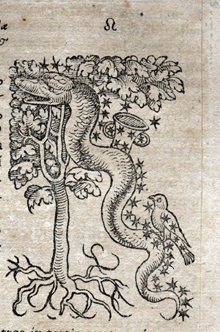
http://www.atlascoelestis.com/hi%20poeticon.htm
Leggi anche:
Arati Solensis
PHAENOMENA ET PROGNOSTICA. Interpretibus M. Tullio Cicerone, Rufo Festo Avieno,
Germanico Caesare, Una cum Eius Commentariis. C.
Iulii Hygini Astronomicon ...
Coloniae Agrippinae (
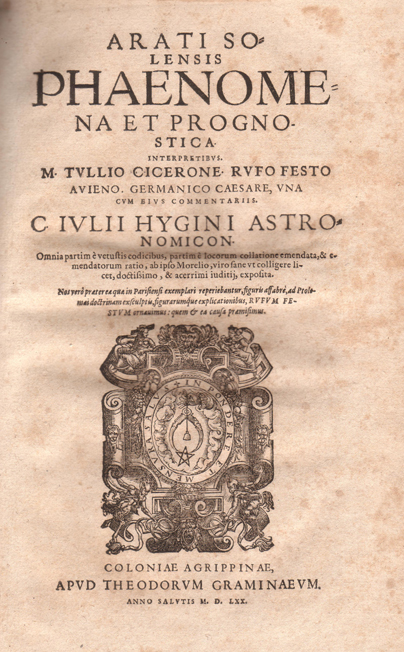
http://www.atlascoelestis.com/Aratus%20Solensis.htm
e
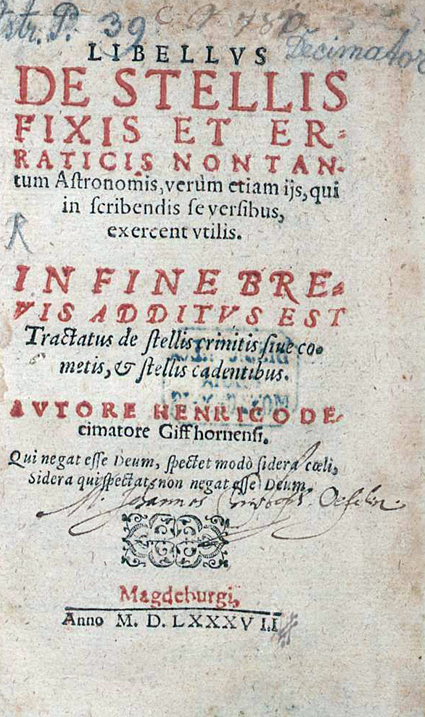
http://www.atlascoelestis.com/decim%20Pagina.htm
Arnaud Zucker
(Université Côte d’Azur, CNRS, CEPAM, France)
Exploring the Relevance of the Star-positions in the Medieval Illuminated Manuscripts of Hyginus' De Astronomia, Venezia 2016-2017
in
http://www.atlascoelestis.com/Zuc%202016.htm
Exploring_the_Relevance_of_the_Star-posi.pdf
Bibliografia
Hyginus, Poeticon Astronomicon, Arhard Ratdolt, Venezia 1482
J. C. Schaubach, Eratosthenis Catasterismi cum interpretazione Latina et commento, Gottingen 1795
A . Rehm, Eratosthenis Catasterismorum Fragmenta Vaticana, Ansbach 1899 http://bvbm1.bib-bvb.de/view/action/singleViewer.do?dvs=1329042423074~125&locale=it&VIEWER_URL=/view/action/singleViewer.do?&DELIVERY_RULE_ID=35&frameId=1&usePid1=true&usePid2=true
J. Martin, Histoire
du texte des Phènomènes d’Aratos, Parigi
Le Boeuffle, Astronomie, Les Belles Lettres, Paris 1983
Patrizio Domenicucci, Astra Caesarum, Astronomia, astrologia e catasterismo da Cesare a Domiziano, Edizioni ETS, Pisa, 1996
Theony Condos, Star Myths of the Greeks and Romans: A Sourcebook containing ‘The Constellations’ of Pseudo Eratosthenes and the ‘Poetic Astronomy’ of Hyginus, Phanes Press, Grand Rapids, 1997
Pascal Charvet, A. Zucker, J. P. Brunet, R. Nadal, Le Ciel, Mythes et histoire des constellations NiL editions, Paris, 1998
J. Pamias Massana, Eratostenes de Cirene, Catasterismes, Barcelona 2004
J. Pamias, K. Geus, Sternsagen, Utopica, Oberhaid, 2007
Arnaud Zucker, La function de l’image dans l’astronomie grecque in Eratosthène. Un atlète du savoir, Publications de l’Université deSaint-Etienne, Saint-Etienne, 2008
Anna Santoni, Eratostene, Epitome dei Catasterismi, Edizioni ETS, Pisa, 2009
G. Chiarini, G. Guidorizzi, Igino Mitologia Astrale, Adelphi, Milano 2009
Elly Dekker, Illustrating the PHAENOMENA, Celestial Cartography in Antiquity an the Middle Ages, Oxford University Press, Oxfor 2013
Anna Santoni, Antiche stelle a Bisanzio, il codice Vaticano greco 1087, Edizioni della Normale, Pisa 2013
J. Pamias I Massana, Arnaud Zucker, Eratosthène de Cyrène, Catastérisme, Les Belles Lettres, Paris, 2013
A. Camerotto, Hybris, i limiti dell'uomo tra acque, cieli e terre, Mimesis edizioni 2014
A. Zucker, Exploring the Relevance of the Star-positions in the Medieval Illuminated Manuscripts of Hyginus' De Astronomia, Venezia 2016-2017 in Certissima Signa, A Venice Conference on Greek and Latin Astronomical Texts, Edizioni Ca’ Foscari-Venezia-settembre 2017
LEGGI DI
Arnaud ZUCKER
(U.N.S., Cepam UMR 6130)
e
Exploring the Relevance of the Star-positions in the Medieval Illuminated Manuscripts of Hyginus' De Astronomia, Venezia 2016-2017 in Certissima Signa, A Venice Conference on Greek and Latin Astronomical Texts, Edizioni Ca’ Foscari-Venezia-settembre 2017
http://www.atlascoelestis.com/Zuc%202016.htm
CONFRONTA CON
f. 10v
Johann Conrad Schaubach
Eratosthenis Catasterismi cum interpretatione latina et commentario
Gottingae 1795
Aratus Solensis
Interpretibus M. Tullio Cicerone, Rufo Festo Avieno, Germanico Caesare, Una cum Eius Commentariis. C. Iulii Hygini Astronomicon...
Coloniae Agrippinae (
Poeticon Astronomicon, Basileae 1570
Hugo Grotius
Syntagma arateorum, Leiden 1600
Hyginus
in
Altre rappresentazioni dell'Aratea o di Igino
Diversi Cycles
Altri lavori di Vopel in Atlascoelestis:
Caspar Vopel
GLOBUS VON VOPELIUS, KÖLNNISCHES STADT-MUSEUM: KSM 1984/447
A Manuscript Celestial Globe, 1532

http://www.atlascoelestis.com/Vopel%201532.htm
SPHAERA / ASTRONOMICA / aeri exarata, sicut / eam olim exhibuit Cas/par Vopelius Cosmogr.
quasi copia di
Caspar Vopel, Caspar. VO / PEL. MEDEBACH / HANC. COSMOGRA: / sphæram faciebat. / Coloniae. UN. 1536

http://www.atlascoelestis.com/Anonimo%20vopel%201536%20base.htm
di FELICE STOPPA
AGOSTO 2019
